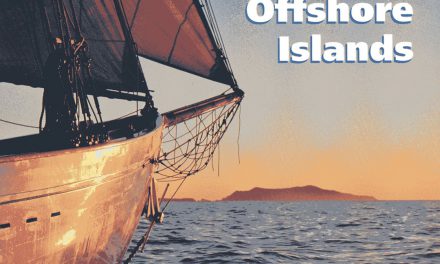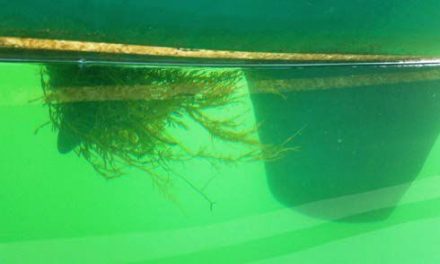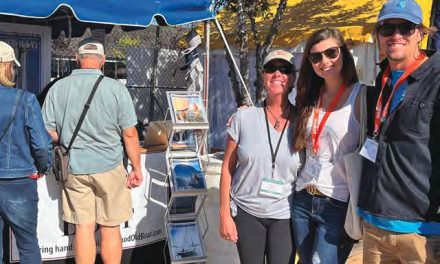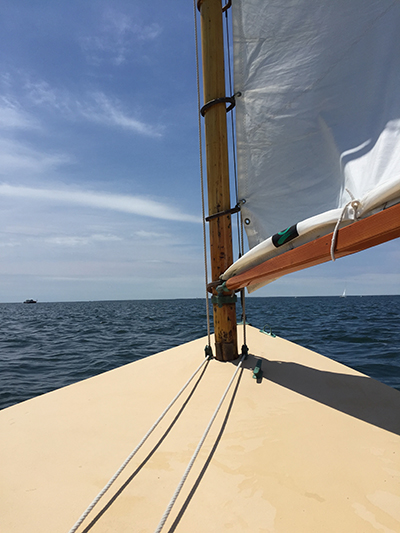An engine failure prompts an unexpected road journey through three states
Issue 153: Nov/Dec 2023
I was pushing up the Intracoastal Waterway (ICW) approaching mile 403 when the engine quit. Again. I was trying to get my newtome old boat home to Maine but had been plagued by engine problems. This was my second year owning Traveller. I had quit my overseas teaching job with an openended sabbatical in mind. Now it was my second summer with the boat, and I had spent my cruising savings on engine repairs. I never expected to haul Traveller overland, but plans change. As it turns out, deciding to put the boat on a trailer was one of the best decisions I’ve ever made.
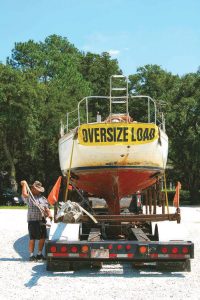
Billy Ray works on the straps holding Traveller to the trailer.
A Pressing Deadline
That Perkins 4107 had been a source of aggravation and a slow drain on my bank account before it eventually let out a massive puff of black smoke and stopped Traveller’s northward push. Don’t get me wrong — Georgetown is a pleasant waterfront town along South Carolina’s stretch of the ICW, but Traveller was still a long way from its home port.
But now, there was a muchneeded new job waiting in Frankfurt, Germany, and a scheduled flight to get there. With a deadline looming, the pressing question became, What to do with the boat? It was much too expensive to just leave the boat in South Carolina.
I drove to the local McDonald’s, ordered a big coffee, plugged in my laptop, and began researching boatyards. Several coffee refills later, I weighed my options. I could leave the boat in my South Carolina mud berth — the marina’s cheaper, back row of floats that went aground at low tide — at a high monthly cost (plus pay a yearly property tax!), or have it hauled overland about 400 miles to a cheaper, longterm storage yard I’d found on the Virginia shore of the Chesapeake Bay.
Dollars Make Sense
Traveller is a 36foot Cheoy Lee Luders offshore sloop, and the cost difference to store it was easy to calculate. The new Virginia boatyard would be about half the cost of the South Carolina marina. OK, that made sense. But would the trucking costs cancel out any storage savings?
I continued searching online, and after two dead ends, I contacted a boat transport clearinghouse. They sent my inquiry to a boathauling company based in North Carolina, which promptly emailed me a quote and asked me to call them. I Skyped and gave them my boat details.
The hauling rate would be $2,990, which included blocking Traveller on the trailer, transit insurance, and all the required permits. This rate worked out to a little over $7 per mile. Travelift fees for getting the boat on and off the trailer were my responsibility.
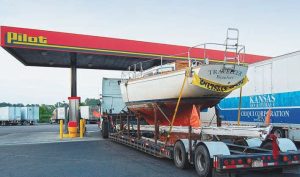
Wrapped with a web of lines, the mast is carried beneath and to the side of the boat.
I calculated that the $2,990 for the hauling, plus one year of cheaper storage in the new boatyard, would equal another year in South Carolina. But additional years in Virginia would add up to a significant saving in storage costs. The cost of hauling the boat 1,000 miles to Maine was out of the question, but more importantly, it wasn’t part of the adventure. I figured I would continue my trek northward at some point in the near future.
I emailed the hauling company back: “Send the truck!”
The next day, the company emailed me a contract. They required a $2,000 wiretransferred deposit before sending the truck. I agreed to their terms, signed their electronic contract, and transferred the deposit through a local bank. The company promptly set a pickup date for the following Monday.
I asked them for suggestions for getting the boat ready. “Plan ahead, secure or remove anything loose on the boat, and have all the boat paperwork in order,” At right, wrapped with a web of lines, the mast is carried beneath and to the side of the boat. Below, Billy Ray’s rig o ered a comfortable ride from South Carolina to Virginia. was the reply. “That’s the key to a smooth transport.”

Billy Ray’s rig offered a comfortable ride from South Carolina to Virginia.
On Monday morning, a massive white cab appeared through the trees. The 18wheeler hissed to a stop in the gravel parking lot; I walked over and introduced myself to the driver.
Billy Ray was a burly man in short pants and heavy shoes. He slid down from the high cab, brushed himself off and announced in a southern drawl, “I’m hungry! Where’s a good place to eat around here?” I suggested an allyoucaneat buffet down the road. He unhitched the trailer. The tide had just turned, and haulout wasn’t for a few hours.
“C’mon, let’s go!” he said, so we climbed into the cool AC of the truck and headed to the diner.
Loading Time
When the tide was high, the yard crew hauled the boat, but they wanted Traveller off the Travelift as soon as possible. While one yard crew attacked the gnarly bottom with a pressure washer and a shovel, the Travelift driver looped a sling under the mast spreaders. Another crew member and I disconnected the shrouds and stays. The mast was lowered onto sawhorses and I turned my attention to arranging the blocking on the trailer.
Billy Ray had brought a pile of wooden blocks, and with a cold drink in hand, he pointed along the backbone of the trailer. “We’ll need a couple here, and here, and here.”
I stacked the blocks where he’d pointed, then looked up and saw Traveller suspended in midair and heading my way. The crew lowered the boat onto the trailer and we set to work adjusting and padding the hydraulic arms. Next, we hefted steel crossbeams across the trailer to support the mast.
Back at the sawhorses, Billy Ray scrutinized the lashings on the stays and shrouds. “Need lots of ropes there, boy. It’s like a hurricane out there on that interstate — 60-mile-per-hour winds. We don’t want nothin’ shaking loose.”
It took six of us to carry the trussed-up mast to the trailer. With the mast secured, Billy Ray leaned a ladder against the hull, inspected the cleared deck, and once again set me to work. I unshackled the anchors and chain and stowed them securely below. Next, I unscrewed the stainless cowls, stowed them, and sealed any missing deck plates with duct tape. I stowed all coiled lines in the lazarettes and secured the lids with small padlocks so they wouldn’t blow open at highway speeds.
The Windex Wind Direction Indicator was a fragile piece to stow. Eventually I settled on a heavy cardboard box, lined it with Tshirts, and stored the box in a locking cabinet.

All oversized loads are required to stop at sunset at designated parking areas.
It was surprising just how many small blocks and bits of line secured the stanchions and lifelines, but they were all removed, labeled, and boxed. I removed the few electronics onboard, rolled them up in towels, and carefully stowed them in deep drawers down below. The sails were already unhanked and bagged, so I wedged them into the V-berth up forward. I disassembled the dodger and bimini frames and stored them on the settee, along with their canvas. An empty “It’s like a hurricane out there on that interstate.” bunk was a good place for the rolled-up, deflated inflatable dinghy.
I turned my attention to the cabin. I’d purchased four large plastic bins from a local DIY store; they were strong and cheap and perfect for packing loose items. I quickly filled them, snapped on their covers, shoved them forward onto the V-berth, and wedged them in with the sail bags.
I drained the freshwater tank, then dogged down the hatches and opening portholes and doublechecked them. Seacocks were closed. The steering wheel was lashed amidships. The boom and spinnaker pole were lashed to cushions on the cabin sole.
Billy Ray eased down the companionway steps and moved fastidiously through the cabin. He pushed things, prodded others, and rattled all the drawers. When nothing moved, he pronounced us roadworthy.
Land Cruising
It must have been 103 degrees when we finally left the boatyard. There were smiles and waves from a line of friends and crew. Then, within 15 minutes, Billy Ray had gotten us stuck in a sprawling, live oak tree along a quiet, shady lane. He jerked the big rig forward and back, struggling to get out from under a lowhanging branch, but Traveller’s stainless steel pulpit had snagged it good. I sweated up to the foredeck and tried to push the branch away.
Billy Ray leaned out of the cab and yelled, “Let’s go! Don’t you worry, she’ll break off.”
I wasn’t sure if he meant the branch or the pulpit. The boat lurched, there was a loud snap, and we were free. Thankfully, it was the branch that had snapped, and with a puff of black smoke and some grinding of gears, we headed north with me riding shotgun, or rather, navigator.
Traveller has a beam of just over 10 feet, exceeding the maximum normal trailer width of 8.5 feet. This meant that the trailer required wide load permits, which put us into a specific hauling category. We were required to stop at sunset and not resume our journey until sunrise. We had to park in designated wide load areas. The boat is a little leggy, too, with a draft of just over 5 feet, so we had to be aware of the height clearance of every overpass on every road, in every town, through every state we crossed. Luckily, the specifications were all listed in books.
Billy Ray had an assortment of almanacs for sunrise and sunset, and guidebooks listing the overpass heights for every highway in every state. As navigator, my job was to get acquainted with the most important one: the United States Truckers Regulations on Oversize Load & Pilot Car Directory. Similar to our pilot books or cruising guides, this essential handbook is updated annually and provides detailed information and regulations related to transporting oversized loads. It includes bridge clearance and parking information, permit requirements, and any other restrictions.
I looked up the references for each of the three states we traversed. As the sun set (and I checked the exact time in the almanac), Billy Ray pulled the rig into a designated wide load parking lot next to a brightly lit Hardee’s restaurant.
The evening air was hot and oppressive. I would sleep in a saloon bunk on Traveller, but it was stuffy in the cabin. I wanted to hook up the little air conditioner that I usually wedged in the companionway hatch.
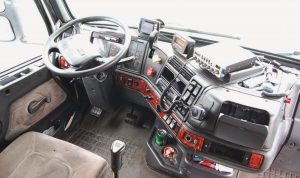
Similar to a boat’s cockpit, this 18-wheeler had radios, GPS, a bunk, and a small fridge.
Not a problem. Billy Ray opened a panel on the side of the truck and unrolled a long extension cord. He plugged the other end into his onboard generator — another land cruising accessory.
A Successful Arrival
We arrived at the Virginia boatyard the next day, and the yard’s Travelift hoisted Traveller off the trailer and onto new blocking and jack stands. The new crew was amiable and helpful.
It was time for Billy Ray to head back to North Carolina, but first I took us out for lunch. And what do you eat when you’re on the Chesapeake? Crab cakes, of course.
There was a firm handshake and a farewell wave. The big rig rumbled off down another interstate highway as I walked back to Traveller. Everything looked fine and nothing was broken. Even the Windex arrived unscathed. Road hauling with Billy Ray was money well spent.
So now we were a few hundred miles further up the ICW. Only a thousand more to get back to Maine. The boat needs to be repowered, and I’ve got my eye on a nice little Beta diesel. It’s available with the same motor mount footprint as the Perkins and might be a relatively easy swap. On the other hand, I might remove the engine entirely, and put an outboard on the dinghy and use it as a pushboat like the traditional, oysterharvesting skipjacks out on the Bay.
But that might just be the Chesapeake influencing me.
David Bond is a writer and artist from Maine. He currently teaches English in Germany while Traveller rests ashore in the Chesapeake. They will continue their adventures together soon. Before wading into teaching, David operated a sailboat chartering business in Kennebunkport, Maine. His book, Adventures in the Charter Trade, is about those crazy times and is available on Amazon.com.
Thank you to Sailrite Enterprises, Inc., for providing free access to back issues of Good Old Boat through intellectual property rights. Sailrite.com


